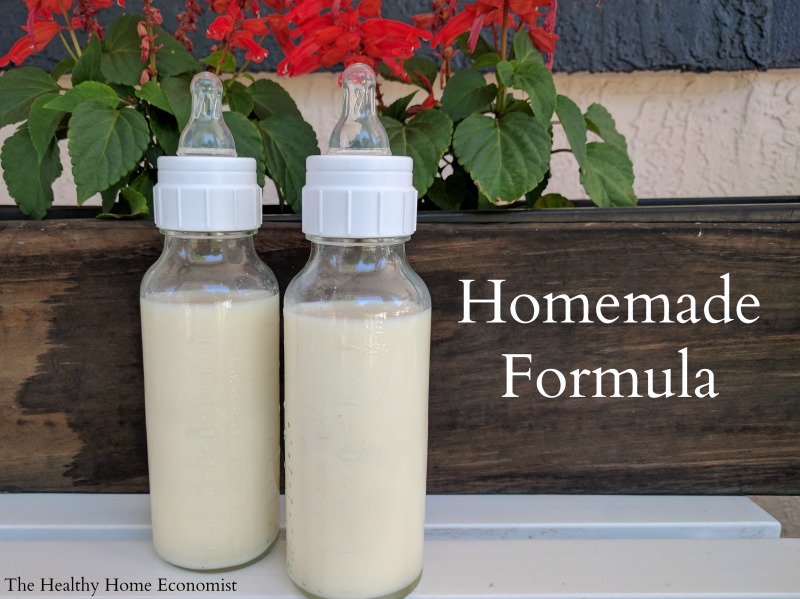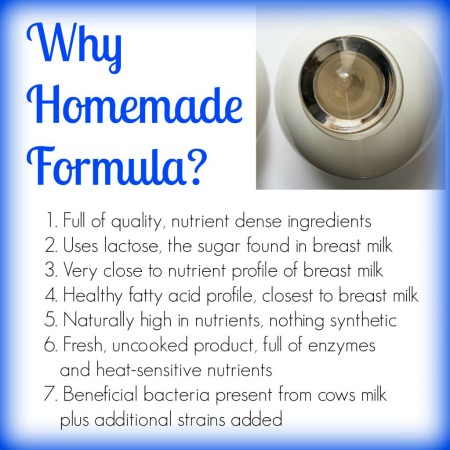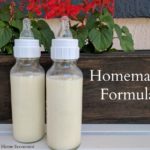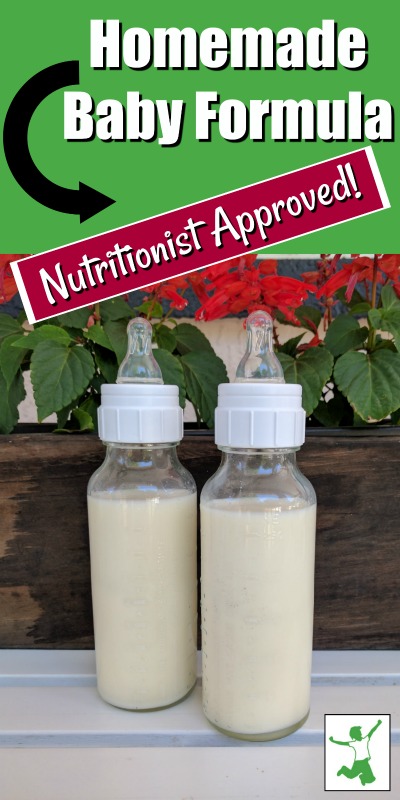Table of Contents[Hide][Show]
A nourishing homemade baby formula using safe, whole ingredients. This recipe was developed and tested by Dr. Mary Enig, a PhD Nutritionist and originally published in Nourishing Traditions cookbook in 1996. It was formulated to match breastmilk as closely as possible and is also suitable for infants. Source: Weston A. Price Foundation

There is no doubt that breastfeeding your baby is the best option for the child’s long-term health and development. Human breastmilk from a well-nourished mother is the perfect food for baby. However, in circumstances where the child is adopted or the Mother finds herself unable to breastfeed, formula feeding becomes necessary. In those cases, homemade baby formula is best.
Using a baby formula recipe that closely matches the nutritional profile of breastmilk is a far better choice than even organic baby formula from the health food store. More on this below.
Note: Donor programs are widely available for human breastmilk. But, the diets of the donor mothers are unknown and most likely nutritionally insufficient. In addition, breastmilk banks pasteurize the donated breastmilk which destroys much of the nutritional benefit. Unless you are fortunate to have a trusted and direct donor milk source in your community, avoid this option!
Dangers of Commercial Formula
Commercial formulas are always a poor choice for a number of reasons. First of all, formula manufacturers line the cans with the chemical BPA. This substance disrupts hormone development and is a probable contributor to early puberty in girls, and ADHD, urogenital abnormalities, and other ills in boys.
The European Food Safety Authority found that canned commercial formula is a significant source of BPA for infants, exposing the child to 13mcg of BPA per kg of body weight per day! BPA-free formula cans are no better. The chemical BPS is typically used instead which is just as dangerous.
Beware that manufacturers pack even organic commercial formula like Earth’s Best in BPA cans. Worse, they use organic brown rice syrup as the primary sweetener which is known to be frequently contaminated with arsenic.
In addition, all commercial milk formulas are processed at extremely high temperatures which violently denature the fragile milk proteins, render them allergenic, and add carcinogens to the final product. Soy infant formula is the worst. Obscenely high processing temperatures not only denature the proteins but large levels of phytic acid in soy block mineral absorption by the infant. Moreover, soy-based plant estrogens disrupt the hormonal development of the baby!
It seems that for the concerned Mother who is unable to breastfeed, learning how to make baby formula at home with safe, pure ingredients is the most prudent way to go!
Why Make Homemade Formula Even if You Are Breastfeeding
In the video below, I show you how to make your own safe, healthy raw milk homemade formula for your baby.
The recipe I follow was originally published in the cookbook Nourishing Traditions in 1996 and developed by Dr. Mary Enig.
Even though I breastfed each of my children for at least 2 years, I made this exact formula for my own children when I was away for the day or the evening as pumping was not an option that worked well for me.
I even used this homemade formula for an entire day once when I had some dental work done and was advised to pump and discard for 24 hours.
As a result, even successfully breastfeeding Moms can use this wonderful homemade formula as a supplement when necessary to their own nutrient-dense breastmilk!
It is advised that even breastfeeding Mothers have the ingredients for this formula on hand for an emergency. If Mom is sick or otherwise unable to nurse, Dad can step in and make this safe alternative until Mom is back on her feet. It takes a few days to a week to gather all the ingredients together to make this formula, which is why I advise having them on hand at all times.
Homemade Most Nutritious
The image below lists the reasons why it is worth it nutritionally to make formula yourself for your precious baby!
You can order all of the required ingredients for the homemade baby formula in one package from this reputable, vetted source.
Moms who have successfully used this formula feeding your children, please post about your experience in the comments section to encourage those who are considering it and need some Mom to Mom encouragement!

Where to Source Quality Milk
The most widely available grass-fed milk around the world is from cows. This is usually the most budget-friendly and easily sourced milk for this recipe for homemade formula.
If only goat milk is available in your area, this recipe for goat milk baby formula can be used instead. When using milk from ewes, please refer to the linked article for an adjusted recipe; one of the benefits of sheep milk is that it is higher in healthy fats than either goat or cow milk.
Camel milk formula is another option that is a particularly digestible form of dairy and growing in popularity around the world.
Alternatively, you can use low temp (vat) pasteurized, non-homogenized whole milk cultured with a piima or kefir starter. Then substitute the piima milk or kefir for the raw milk portion of the formula recipe. Cold-pressed raw milk also must be cultured before using it as it contains no probiotics.
Do NOT use ultrapasteurized (UHT) milk even if organic as it is too highly processed and extremely allergenic!
It is also best to avoid all types of powdered milk for this recipe. The factory process of making milk powder reduces nutrition considerably and denatures it, which makes it more likely baby will have an allergic reaction.
Dairy Allergy Option
If all types of dairy prove unsuitable for your baby, make this nondairy baby formula recipe instead. It uses a base of homemade bone broth as a substitute for milk. It is important not to utilize a plant-based or otherwise vegan baby formula recipe.
Avoid buying bone broth to make the dairy-free formula. Make it yourself! Manufacturers of commercial bone broth, even if authentic, may water down the end product. This is apparent if it does not gel when chilled in the refrigerator.
Many brands have toxic packaging issues as well. If you must buy it in a pinch, see my shopping guide page for vetted brands that are safe.

Homemade Baby Formula Recipe (for infants too)
A nourishing baby formula recipe you can make at home with safe, whole ingredients developed and tested by a PhD nutritionist to match breastmilk as closely as possible. Also suitable for infants.
Ingredients
- 2 cups raw cow milk OR organic whole milk yogurt
- 1 7/8 cups filtered water
- 1/4 cup liquid whey
- 4 Tbl lactose
- 1/4 tsp Bifidobacterium infantis powder
- 2-4 Tbl raw or pasteurized cream
- 1/2 tsp cod liver oil unflavored
- 1/4 tsp butter oil unflavored
- 1 tsp sunflower oil preferably organic
- 1 tsp extra virgin olive oil preferably organic
- 2 tsp virgin coconut oil preferably organic
- 2 tsp nutritional yeast
- 2 tsp gelatin
- 1/4 tsp acerola powder
Instructions
-
Fill a 2 cup Pyrex measuring cup with filtered water and remove 2 TBL (this will give you 1 7/8 cup water).
-
Pour about half the water into a pan and turn burner on medium.
-
Add the gelatin and lactose and let dissolve, stirring occasionally.
-
When gelatin and lactose are dissolved, remove pan from heat and add the rest of the water to cool.
-
Stir in the coconut oil and butter oil until melted.
-
Put remaining ingredients in a glass blender.
-
Add the water mixture and blend for about 3 seconds.
-
Place formula in glass baby bottles or a glass jar and refrigerate.
-
Before giving to baby, warm glass bottle in a pan of hot water or a bottle warmer. NEVER microwave baby bottles!
Recipe Video
Recipe Notes
If using raw cow milk from holstein cows, use 4 Tbl of extra cream (otherwise use 2 Tbl extra cream).
If choosing to make this homemade formula with camel milk, be sure to include 4 Tbl extra cream as camel milk is lower in cream than cow milk.
Do not use high oleic sunflower oil. Use only the brand recommended in the ingredients list which is cold pressed, organic, unrefined, and low oleic.
*Do NOT use powdered whey from the store as it is denatured. Avoid whey from making cheese as it will curdle the formula.
*Do not substitute pasteurized or powdered milk as these are heavily processed, denatured and allergenic foods.
*Do NOT use ultrapasteurized (UHT) cream. It is highly allergenic. Raw or pasteurized cream is acceptable.
*Do NOT use fish oil or krill oil instead of high vitamin cod liver oil as they do not contain any Vitamin D and very little to no Vitamin A.
Collagen powder may be substituted for the gelatin in a pinch (more on peptides in baby formula in this article).
If you are wondering where is the iron in homemade baby formula, this article provides an explanation.
If baby experiences constipation using this formula, try adding 1 tsp of molasses to each batch. This should help move things along.
How to Transition to DIY Formula
Once you’ve viewed the video, gathered the ingredients, and made your first batch, how do you feed it to your baby for the first time?
It is important not to switch all at once as this can cause gas, excessive spit-up, or an uncomfortable change in diaper habits such as constipation or overly loose stools.
Start by giving your baby three-quarters of the old formula blended with one-quarter of the homemade. Try this ratio for a day or two and see how your infant responds.
If no digestive upset or major change in diaper habits occurs, increase the amount to a 50-50 blend of old formula to homemade. Observe for another day or two as before.
If no major issues, increase once again to three-quarters homemade formula to one-quarter old formula. If baby does well on this blend for a third time, you are ready to fully transition to the homemade formula.
At any time during the transition, symptoms of intolerance emerge, back up to the previous successful blend ratio and stay there for a day or two before attempting to increase once again.
Homemade Formula FAQ
Weston Price Foundation
Feeding an Adopted Baby
Traveling Tips with Baby Formula Made at Home
Iron in Baby Formula
Collagen Peptides instead of Gelatin for Homemade Formula?










My baby projectile vomited about 2 hours after eating the formula. What are some things I could eliminate that could be causing this? I heard maybe gelatin or cod liver Oil? (we did not put nutritional yeast in it) Thank you so much!
Did you switch to the homemade formula 100% all at once? If so, you need to transition slowly over a week or two mixing with what the baby is currently drinking.
Two more questions- I know it is normal for the formula to thicken in the fridge. But mine is thickening to the point where I cant even pour it out. Is that normal? Should I just spoon it into the bottles?
And- my coconut oil has separated- the thick creamy oil is in the upper part of the jar and there is a layer of liquid oil at the bottom. Is it okay to just scoop the portion from the top? Or do I need to somehow blend the coconut oil to a consistent consistency?
If your coconut oil has separated, just stir with a spoon and then scoop enough out to make the batch of formula.
Yes, it is normal because of the gelatin which coagulates when chilled. Just spoon out some thickened formula into a bottle and then warm and it will re-liquefy.
Hello Sarah,
I saw in an earlier comment it’s the whey that’s sours in 24-48 hours. Is that the only ingredient that spoils that quickly ? Would it be possible to mix the rest of the ingredients and add just the whey say 2-3 days later ? How long will it last in the freezer?
Whey does not spoil quickly. I have some in my fridge that is a month old. You really need to make the formula fresh every day or two. You can freeze individual portions in breastmilk bags and it will last several months.
And what about using yogurt? My local store sells a yogurt brand that is fermented 24 hours. Would you use yogurt the same way as you would kefir? Does the extra thickness not mess things up?
If it is plain and whole milk, then yes. You can use that! The thickness is fine as it gets diluted a bit with the water. Use it just like kefir.
Do you know of specific brands of store-bought kefir or yogurt that can be used with the formula- as opposed to making my own? Does the kefir have to be made with kefir grains or does it just need to ferment for a full 24 hours?
The kefir is made with low temp, nonhomogenized pasteurized milk or raw milk with kefir grains OR a packet of powdered kefir culture and fermented for a full 24 hours. I don’t know of any store brands fermented this long, but in a pinch, you can use an organic plain kefir like Maple Hill.
You mention that this is not for a child after age 1? what is recommended after this age? thanks
Plain grassfed milk … preferably fresh!
Hi Sarah, you mentioned in this article about altering raw milk for low temp pasteurized whole milk (non homogenized) that is cultured. Does the milk culture mean clabbered milk or kefir milk? Thank you!
Yes, you can make this formula with 24 hour kefir or yogurt made from low temp pasteurized milk. You can’t clabber low temp pasteurized milk, so that part wouldn’t work.
Hi SARAH
How long does 1 recipe of this last in the fridge? We have a newborn who is just supplementing low breastmilk supply and only drinking maybe 8 oz a day of formula right now. Thanks
As mentioned in the article, homemade formula is best made every day. Every other day is the most infrequent you should consider. If you won’t use the whole recipe, make 1/2 or 1/4 batches at a time. The reason is that the whey added to the milk sours the formula after 24-48 hours. You can freeze some freshly made in breastmilk bags for emergencies if you like.
Hi Sarah, I have another question for you. When my baby first started the raw milk formula he would poop everyday. Lately he’s been pooping every other day and his poop is a large ball/clay texture. I read how to relieve constipation with the homemade baby formula on your website so I went ahead and changed the coconut oil to 1 tablespoon and added one more tablespoon of cream (total now I use are 5 tablespoons of cream). However, none of the changes have made a difference. Should I also try adding the dark molasses or what do you recommend?
Thank you,
Cathy
I am not qualified to answer these types of questions. If the normal remedies don’t work as suggested in the baby constipation article, there is possibly something else going on … you really need to reach out to a trusted practitioner in your area and have the child seen.
Hello again Sarah! We’ve got a special situation on our hands and I’m wondering about this formula. Bob is 18 months old. He is on a very restricted diet due to tons of sensitivities (along with eczema and constipation issues) and his practitioners have put him on a commercial amino acid based toddler formula. We are stuck in a cycle. Can’t add new foods because the formula has him flared, can’t stop the formula because he falls underweight quickly. Anyway..this formula wouldnt be harmful to an older child, would it? Also, we know he us sensitive to coconut..actually suffering through a reaction as we speak. Tips on subsitute? Just leave it out? Thanks!
You really need to consult with a specialist on that. This formula is not designed for the nutritional needs of a child beyond age 1.